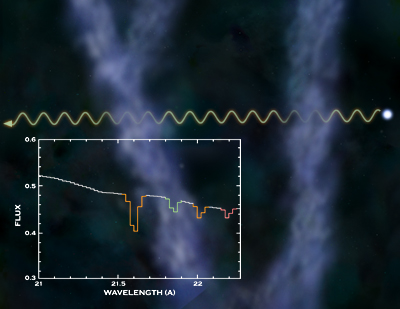February 2, 2005
CXC RELEASE: 05-01
NASA's Chandra X-ray Observatory has discovered two huge intergalactic clouds of diffuse hot gas. These clouds are the best evidence yet that a vast cosmic web of hot gas contains the long-sought missing matter - about half of the atoms and ions in the Universe.
Various measurements give a good estimate of the mass-density of the baryons - the neutrons and protons that make up the nuclei of atoms and ions - in the Universe 10 billion years ago. However, sometime during the last 10 billion years a large fraction of the baryons, commonly referred to as "ordinary matter" to distinguish them from dark matter and dark energy, have gone missing.
"An inventory of all the baryons in stars and gas inside and outside of galaxies accounts for just over half the baryons that existed shortly after the Big Bang," explained Fabrizio Nicastro of the Harvard-Smithsonian Center for Astrophysics, and lead author of a paper in the 3 February 2005 issue of Nature describing the recent research. "Now we have found the likely hiding place of the missing baryons."
Nicastro and colleagues did not just stumble upon the missing baryons - they went looking for them. Computer simulations of the formation of galaxies and galaxy clusters indicated that the missing baryons might be contained in an extremely diffuse web-like system of gas clouds from which galaxies and clusters of galaxies formed.
These clouds have defied detection because of their predicted temperature range of a few hundred thousand to a million degrees Celsius, and their extremely low density. Evidence for this warm-hot intergalactic matter (WHIM) had been detected around our Galaxy, or in the Local Group of galaxies, but the lack of definitive evidence for WHIM outside our immediate cosmic neighborhood made any estimates of the universal mass-density of baryons unreliable.
The discovery of much more distant clouds came when the team took advantage of the historic X-ray brightening of the quasar-like galaxy Mkn 421 that began in October of 2002. Two Chandra observations of Mkn 421 in October 2002 and July 2003, yielded excellent quality X-ray spectral data. These data showed that two separate clouds of hot gas at distances from Earth of 150 million light years and 370 million light years were filtering out, or absorbing X-rays from Mkn 421.
The X-ray data show that ions of carbon, nitrogen, oxygen, and neon are present, and that the temperatures of the clouds are about 1 million degrees Celsius. Combining these data with observations at ultraviolet wavelengths enabled the team to estimate the thickness (about 2 million light years) and mass density of the clouds.
Assuming that the size and distribution of the clouds are representative, Nicastro and colleagues could make the first reliable estimate of average mass density of baryons in such clouds throughout the Universe. They found that it is consistent with the mass density of the missing baryons.
Mkn 421 was observed three times with Chandra's Low-Energy Transmission Grating (LETG), twice in conjunction with the High Resolution Camera (May 2000 and July 2003) and once with the Advanced CCD Imaging Spectrometer (October 2002). The distance to Mkn 421 is 400 million light years.
NASA's Marshall Space Flight Center, Huntsville, Ala., manages the Chandra program for NASA's Office of Space Science, Washington. Northrop Grumman of Redondo Beach, Calif., formerly TRW, Inc., was the prime development contractor for the observatory. The Smithsonian Astrophysical Observatory controls science and flight operations from the Chandra X-ray Center in Cambridge, Mass.
http://chandra.harvard.edu
and
http://chandra.nasa.gov
MEDIA CONTACTS
Steve Roy
Marshall Space Flight Center, Huntsville, AL
Phone: 256-544-6535
Megan Watzke
Chandra X-ray Observatory Center, CfA, Cambridge, MA
Phone: 617-496-7998





